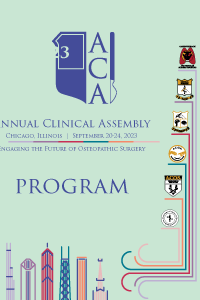General Surgery
Two large Right breast tubular adenomas in a postpartum 15 year old female: a case report
Location: Grandball Room 1-2
- ZF
Zachary R. Floyd, DO
Kettering Health Dayton/Grandview Medical Center
Kettering, Ohio, United States
Primary Presenter(s)
Introduction/Purpose:
Tubular adenoma of the breast is a rare, benign neoplasm most commonly found in women of childbearing age and present as well circumscribed masses often clinically and radiographically labeled as fibroadenomas. They require surgical excision to establish histological diagnosis and prevent their further enlargement (3).
Methods or Case Description:
15 year old female approximately 5 months gestation presented for surgery consult with palpable enlarging right breast mass and intermittent discomfort. She had undergone an Ultrasound of the right breast that showed a 4.2 x 4.1 x 3.1 cm suspicious BIRADS Category 4 lesion. She underwent Ultrasound guided biopsy which revealed tubular adenoma. Given the increasing size and patient discomfort/symptomatology excision was recommended after completion of her pregnancy. She presented approximately 10 weeks after delivery and underwent excisional biopsy of her right breast mass and was found to have two large distinct circumscribed masses 5.5 x4.7 x 3.8 cm and 6.6 x 6.3 x 5.6 cm, both found to be tubular adenomas without atypia or malignancy.
Outcomes: She presented approximately 10 weeks after delivery and underwent excisional biopsy of her right breast mass and was found to have two large distinct circumscribed masses 5.5 x4.7 x 3.8 cm and 6.6 x 6.3 x 5.6 cm, both found to be tubular adenomas without atypia or malignancy.
Conclusion:
Benign enlarging and symptomatic breast masses are common among women of childbearing age. Albeit rare, cancer should always be a consideration as to avoid delay in diagnosis and treatment. Our patient presented at 5 months gestation with a large 4.2 x 4.1 x 3.1 cm oval circumscribed hypoechoic mass with internal blood flow categorized as BIRADS category 4 suspicious seen on right breast ultrasound that was confirmed as tubular adenoma on needle biopsy. Lesions classified as BIRADS category of 4 (suspicious) should be biopsied to establish tissue diagnosis especially during pregnancy where benign lesions appear suspicious and conversely some cancerous lesions may appear reassuring on breast imaging [1,2]. Given the rarity of Tubular breast adenomas, malignant transformation and coexistence of carcinoma with tubular adenoma have only been reported in a few cases, including a 33 year old female with an 18 year history of tubular adenoma that follow up imaging and biopsy found coexistent DCIS [4]. Our patient underwent excisional biopsy 10 weeks after delivery and was found to have two large distinct right breast masses 5.5 x4.7 x 3.8 cm and 6.6 x 6.3 x 5.6 cm respectively, both of which were found to be tubular adenoma without malignancy. Only one mass was seen on both original right breast ultrasound and ultrasound guided biopsy, if not for open excisional biopsy the second mass would have not been identified and would have delayed potential diagnosis and treatment if a malignant lesion had been present.
Tubular adenoma of the breast is a rare, benign neoplasm most commonly found in women of childbearing age and present as well circumscribed masses often clinically and radiographically labeled as fibroadenomas. They require surgical excision to establish histological diagnosis and prevent their further enlargement (3).
Methods or Case Description:
15 year old female approximately 5 months gestation presented for surgery consult with palpable enlarging right breast mass and intermittent discomfort. She had undergone an Ultrasound of the right breast that showed a 4.2 x 4.1 x 3.1 cm suspicious BIRADS Category 4 lesion. She underwent Ultrasound guided biopsy which revealed tubular adenoma. Given the increasing size and patient discomfort/symptomatology excision was recommended after completion of her pregnancy. She presented approximately 10 weeks after delivery and underwent excisional biopsy of her right breast mass and was found to have two large distinct circumscribed masses 5.5 x4.7 x 3.8 cm and 6.6 x 6.3 x 5.6 cm, both found to be tubular adenomas without atypia or malignancy.
Outcomes: She presented approximately 10 weeks after delivery and underwent excisional biopsy of her right breast mass and was found to have two large distinct circumscribed masses 5.5 x4.7 x 3.8 cm and 6.6 x 6.3 x 5.6 cm, both found to be tubular adenomas without atypia or malignancy.
Conclusion:
Benign enlarging and symptomatic breast masses are common among women of childbearing age. Albeit rare, cancer should always be a consideration as to avoid delay in diagnosis and treatment. Our patient presented at 5 months gestation with a large 4.2 x 4.1 x 3.1 cm oval circumscribed hypoechoic mass with internal blood flow categorized as BIRADS category 4 suspicious seen on right breast ultrasound that was confirmed as tubular adenoma on needle biopsy. Lesions classified as BIRADS category of 4 (suspicious) should be biopsied to establish tissue diagnosis especially during pregnancy where benign lesions appear suspicious and conversely some cancerous lesions may appear reassuring on breast imaging [1,2]. Given the rarity of Tubular breast adenomas, malignant transformation and coexistence of carcinoma with tubular adenoma have only been reported in a few cases, including a 33 year old female with an 18 year history of tubular adenoma that follow up imaging and biopsy found coexistent DCIS [4]. Our patient underwent excisional biopsy 10 weeks after delivery and was found to have two large distinct right breast masses 5.5 x4.7 x 3.8 cm and 6.6 x 6.3 x 5.6 cm respectively, both of which were found to be tubular adenoma without malignancy. Only one mass was seen on both original right breast ultrasound and ultrasound guided biopsy, if not for open excisional biopsy the second mass would have not been identified and would have delayed potential diagnosis and treatment if a malignant lesion had been present.

